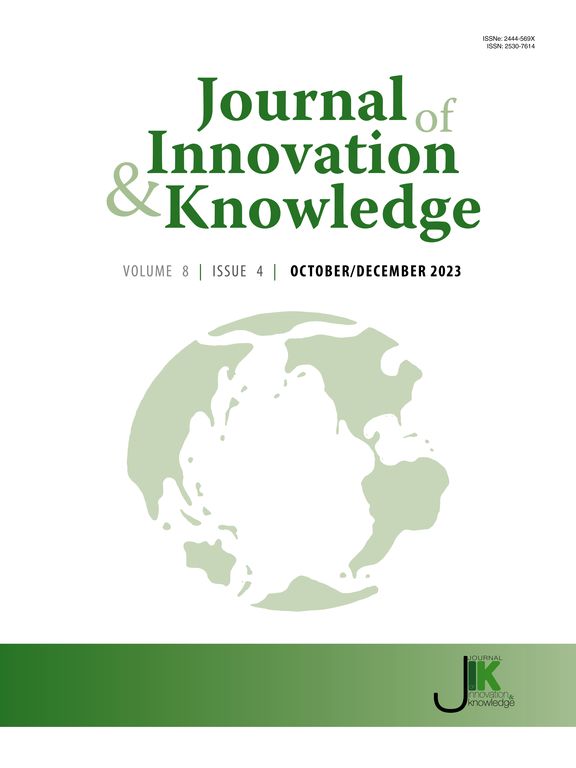资源配置模式对绿色技术创新效率的影响:环境资源协调与企业数字化能力的协同作用
IF 15.5
1区 管理学
Q1 BUSINESS
引用次数: 0
摘要
随着环境问题受到越来越多的关注,对环境资源的投资不断增加,导致了许多绿色技术创新(GTI)。然而,在资源有限的情况下,探索绿色技术创新效率(GTIE)成为一个更有意义的话题。有效配置环境资源有利于提高GTIE水平。然而,在数字时代,数字能力在赋予环境资源编排以增强GTIE方面的过程仍不清楚。因此,本研究旨在基于制度理论和资源协调理论(ROT),科学地评估企业的GTIE,探索环境资源协调与企业数字化能力之间的协同作用。采用Malmquist指数结合数据包络分析(Malmquist- dea)从动态角度对企业的GTIE进行评价。采用模糊集定性比较分析(FsQCA)方法研究协同效应。结果表明:(1)构建的投入产出指标提供了综合衡量企业绩效绩效的指标,上市公司的企业绩效绩效随时间呈上升趋势;(2)环境资源协调与数字能力之间的协同作用通过竞争优势的相互增强或补偿促进了GTIE的发展。具体来说,数字能力使环境资源的有效获取和部署成为可能,而环境资源编排推动了对数字基础设施的更大需求。(3)它们的协同作用进一步形成了四种资源配置模式,包括与高gtie相关的压力响应模式(PRM)和主动竞争模式(ACM),以及与非高gtie相关的定型发展模式(SDM)和盲目发展模式(BDM)。本研究为政府和企业实施GTI实践提供了有益的见解和指导。本文章由计算机程序翻译,如有差异,请以英文原文为准。
Resource allocation pattern to green technology innovation efficiency: Synergy between environmental resource orchestration and firms' digital capabilities
As environmental concerns receive increasing attention, investments in environmental resources have grown, leading to numerous green technology innovations (GTI). Yet, amid limited resources, exploring green technology innovation efficiency (GTIE) becomes a more meaningful topic. Efficient allocation of environmental resources is beneficial for enhancing GTIE. However, in the digital era, the process of digital capabilities in empowering environmental resource orchestration to enhance GTIE remains unclear. Therefore, based on institutional theory and resource orchestration theory (ROT), this study aims to scientifically assess firms’ GTIE and explore the synergy between environmental resource orchestration and firms’ digital capabilities. Malmquist index combined data envelopment analysis (Malmquist-DEA) was used to evaluate the GTIE of firms from a dynamic perspective. Fuzzy-set qualitative comparative analysis (FsQCA) method was utilized to investigate synergy effects. The results reveal that: (1) The constructed input-output indicators provide a comprehensive measure of GTIE, and the listed firms’ GTIE shows an upward trend along time; (2) The synergy between environmental resource orchestration and digital capabilities fosters GTIE through mutual enhancement or compensation of competitive advantages. Specifically, digital capabilities enable the efficient acquisition and deployment of environmental resources, while environmental resource orchestration drives greater demand for digital infrastructure. (3) Their synergy further developed four resource allocation patterns, including Pressure Response Model (PRM) and Active Competitive Model (ACM) associated with High-GTIE, as well as Stereotyped Development Model (SDM) and Blind Development Model (BDM) associated with Nonhigh-GTIE. This research provides beneficial insights and guidelines for governments and corporates to implement GTI practices.
求助全文
通过发布文献求助,成功后即可免费获取论文全文。
去求助
来源期刊

Journal of Innovation & Knowledge
Multiple-
CiteScore
16.10
自引率
12.70%
发文量
118
审稿时长
37 days
期刊介绍:
The Journal of Innovation and Knowledge (JIK) explores how innovation drives knowledge creation and vice versa, emphasizing that not all innovation leads to knowledge, but enduring innovation across diverse fields fosters theory and knowledge. JIK invites papers on innovations enhancing or generating knowledge, covering innovation processes, structures, outcomes, and behaviors at various levels. Articles in JIK examine knowledge-related changes promoting innovation for societal best practices.
JIK serves as a platform for high-quality studies undergoing double-blind peer review, ensuring global dissemination to scholars, practitioners, and policymakers who recognize innovation and knowledge as economic drivers. It publishes theoretical articles, empirical studies, case studies, reviews, and other content, addressing current trends and emerging topics in innovation and knowledge. The journal welcomes suggestions for special issues and encourages articles to showcase contextual differences and lessons for a broad audience.
In essence, JIK is an interdisciplinary journal dedicated to advancing theoretical and practical innovations and knowledge across multiple fields, including Economics, Business and Management, Engineering, Science, and Education.
 求助内容:
求助内容: 应助结果提醒方式:
应助结果提醒方式:


